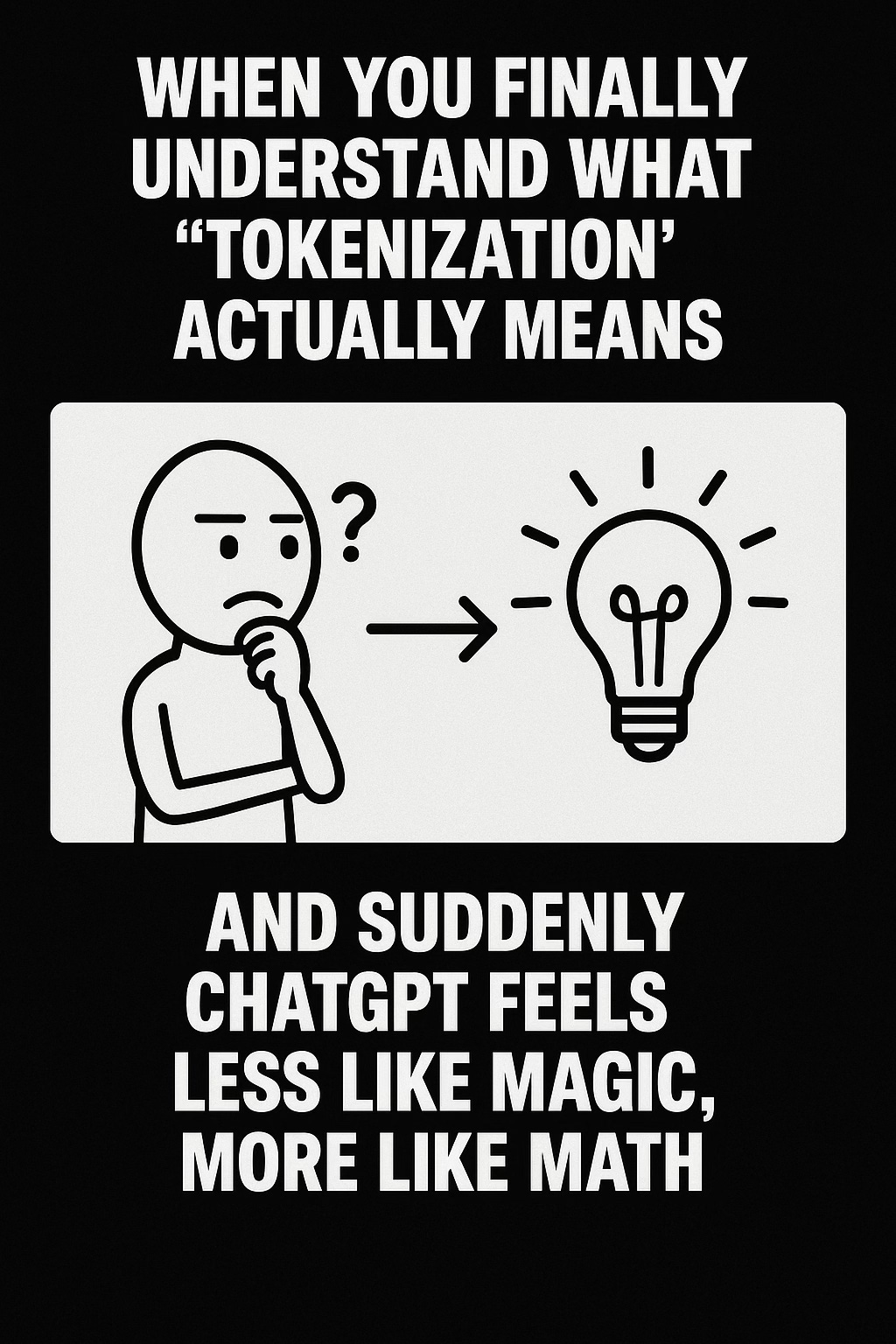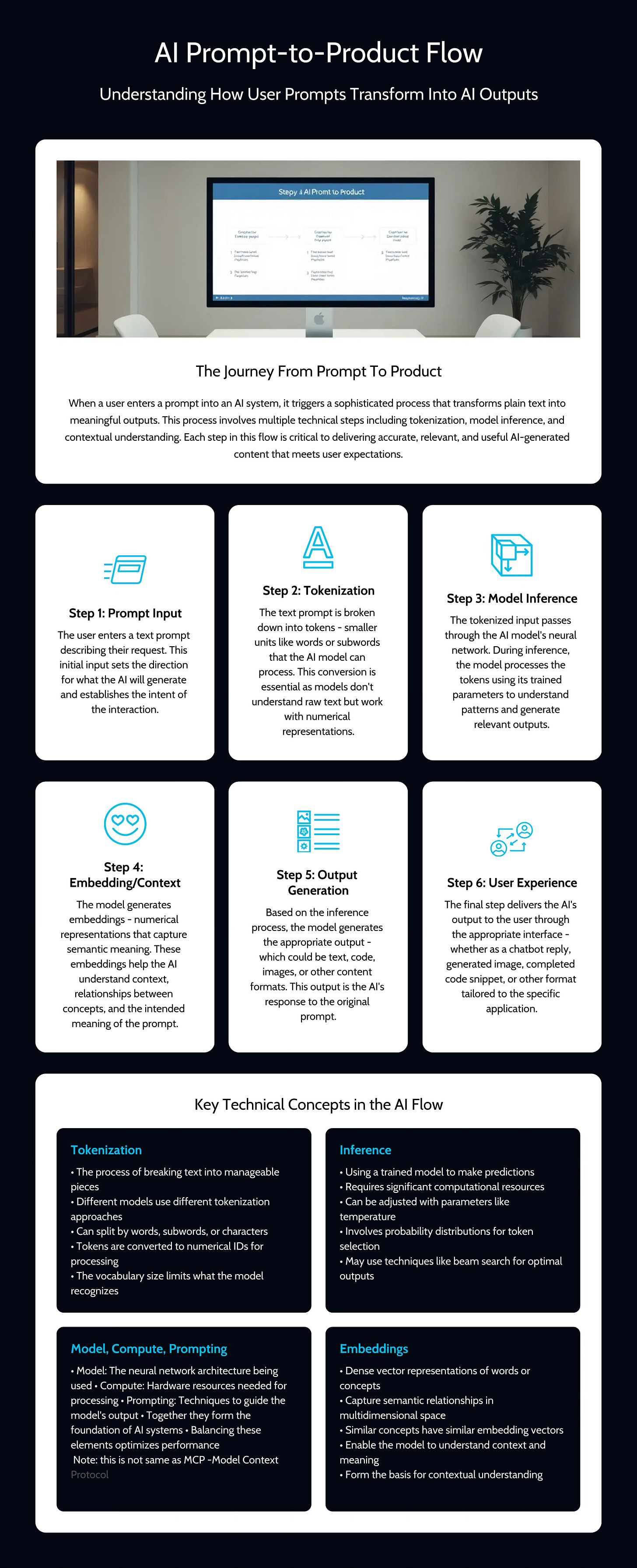⚪️50 Essential AI Terms to Help You Speak AI with Confidence
Unlock the language of AI, 50 terms to guide your next big idea.
This 50 AI terms will make you understand and join conversations about artificial intelligence with ease. Each term is explained in plain language with relatable examples!
Bonus Visual Below to Help You Connect the Dots
To make this even more practical, I’ve included a bonus visual at the end of this post. It breaks down the flow of what happens from a prompt to an intelligent outcomes using the terms in this guide.
This helps anchor the 50 terms in a real-world context and gives you a clearer picture of how AI actually works across everyday systems.
Artificial Intelligence (AI): Machines mimicking human intelligence, learning, problem-solving, decision-making. Example: ChatGPT summarizing your Zoom meeting notes.
Machine Learning (ML): A subset of AI where computers learn patterns from data. Example: TikTok recommending videos based on your watch history.
Deep Learning: A type of ML using neural networks with many layers to model complex patterns. Example: Tesla’s Autopilot detecting lanes and obstacles in real-time.
Natural Language Processing (NLP): Teaching machines to understand, generate, and respond in human language.Example: Google’s Bard summarizing a research paper.
Generative AI: AI that creates new content, text, images, code, music, from learned data. Example: OpenAI Sora generating a video based on a written prompt.
Neural Network: Inspired by the human brain, it's a network of nodes (neurons) used in deep learning. Example: AI generating synthetic voices that sound human.
Computer Vision: AI interpreting visual data from the world, images and video. Example: iPhone using Face ID to unlock your phone.
Reinforcement Learning: AI learns by trial-and-error, receiving feedback through rewards or penalties. Example: Google DeepMind’s AI controlling data center energy usage.
Large Language Model (LLM): A type of generative AI trained on massive text datasets to understand and generate human language. Example: Claude helping draft policies for your business.
Prompt Engineering: Crafting effective instructions to guide AI responses. Example: Asking ChatGPT to generate LinkedIn posts tailored to your industry.
Token: The smallest unit of text AI reads or generates, like words or sub-words. Example: GPT splitting “sustainable” into smaller language tokens.
Tokenization: A process of breaking down text into smaller units (called tokens) that a language model can understand and process. Tokens can be full words, parts of words (like prefixes or suffixes), or even individual characters, depending on the model. Example: The sentence “AI is powerful” might be tokenized into ["AI", " is", " powerful"] or ["A", "I", " is", " power", "ful"] depending on how the model is built. Tip: Think of tokenization like translating your message into the model’s internal language, before it can “think,” it needs to break the sentence into tokens it understands.
Token Limit: The maximum number of tokens (words/characters) an AI can process in one go. Example: GPT-4-turbo handling entire books in a single session.
Inference: The process of an AI making predictions or outputs based on input. Example: Grammarly suggesting sentence improvements in real time.
Training: The process of teaching AI models using large datasets. Example: Meta training LLaMA on multilingual content.
Fine-tuning: Adjusting a pre-trained model for a specific task or domain. Example: Customizing ChatGPT to sound like your brand voice.
Embedding: Turning words, images, or data into numerical vectors for AI to understand relationships. Example: Powering Spotify’s “similar songs” feature.
Chatbot: An AI program that simulates human conversation. Example: Klarna’s AI assistant helping you track online purchases.
Hallucination (AI): When AI generates outputs that sound confident but are false or inaccurate. Example: AI misquoting a source in a blog summary.
Bias (in AI): When AI models reflect or amplify prejudices found in training data. Example: Resume screening tools favoring certain demographics.
Data Labeling: Tagging or annotating data to help AI learn. Example: Labeling TikTok videos as cooking or comedy for algorithm training.
Supervised Learning: AI learns from labeled data with correct answers. Example: Training an email filter to spot phishing emails.
Unsupervised Learning: AI finds patterns in unlabeled data. Example: YouTube clustering viewers into interest segments.
Semi-Supervised Learning: AI learns from a mix of labeled and unlabeled data. Example: AI improving ad targeting using partial click-through data.
Foundation Model: A large-scale AI model trained on diverse data that can be adapted for multiple tasks. Example: OpenAI’s GPT-4 being used in Microsoft Copilot.
Transformer: A neural network architecture behind LLMs that enables better language understanding. Example: The architecture behind most chat-based AI tools today.
Model Context Protocol (MCP): A framework that helps AI models connect with various services, databases and APIs in a standardized way.
Example: GPT having more knowledge due to connections to favorite data sources from other connected services to provide context rich responses.
Vision-Language Model (VLM): Models that understand both images and text. Example: GPT-4V analyzing screenshots and answering questions.
Text-to-Image: AI generating pictures based on text prompts. Example: Adobe Firefly creating marketing banners from a few words.
Text-to-Speech (TTS): AI converting written words into spoken voice. Example: ElevenLabs creating realistic AI-generated narration.
Speech Recognition: AI converting spoken language into text. Example: Otter.ai transcribing meetings in real time.
Zero-Shot Learning: AI performing tasks it wasn't explicitly trained for. Example: ChatGPT answering a domain-specific question it wasn’t trained on.
Few-Shot Learning: AI learns new tasks from just a few examples. Example: Showing GPT a few examples of sales outreach emails, then asking it to generate more.
Multimodal AI: AI that understands and combines different data types, text, images, audio. Example: ChatGPT reading an image and explaining what it shows.
Synthetic Data: Artificially generated data used to train or test AI. Example: Simulated driving footage used to train autonomous vehicles.
Explainability: How clearly an AI's decision-making can be understood. Example: Tools like Fiddler or ExplainX showing why AI made a decision.
Ethical AI: Developing and using AI responsibly, fair, transparent, unbiased. Example: Companies publishing AI ethics policies before launch.
Model Drift: When an AI model's performance worsens over time due to changing data. Example: Customer churn prediction model becoming less accurate post-COVID.
Data Pipeline: The process of collecting, cleaning, and moving data for AI use. Example: Using Airbyte to move app data to a data warehouse for AI models.
Model Deployment: Putting a trained AI model into real-world use. Example: Embedding ChatGPT into customer support workflows.
Tuning: Adjusting AI model parameters for better performance. Example: Optimizing your open-source model for speed on limited devices.
LLMOps: Tools and practices for managing and monitoring large language models in production. Example: Using Weights & Biases to track model metrics across deployments.
Vector Database: A database optimized for storing and retrieving embeddings. Example: Using Pinecone to power fast semantic search in your app.
RAG (Retrieval-Augmented Generation): Combining LLMs with external data sources to generate grounded answers. Example: ChatGPT browsing company knowledge base to answer support questions.
Knowledge Graph: Structured information about concepts and their relationships. Example: Google’s Knowledge Graph powering instant answers in search.
Open-Source Model: An AI model whose code is publicly available. Example: Mistral 7B released for developers to experiment and build with.
Closed-Source Model: A proprietary AI model not publicly accessible. Example: Gemini Pro inside Google Workspace.
API (Application Programming Interface): A way for software to communicate and use AI capabilities. Example: Zapier calling the OpenAI API to automate weekly summaries.
Agentic AI / AI Agents: AI systems that can plan, reason, and act autonomously toward goals. Example: Claude with tool use(Anthropic) executes multi-step tasks across tools and APIs, based on user instructions and goal, demonstrating agentic planning and action.
Intelligent Product A product that uses data and AI to learn, adapt, and improve performance over time, with minimal human input. Example: ChatGPT (with memory enabled) remembers your preferences and past interactions to tailor future conversations and suggestions.
Use this glossary to navigate your AI journey confidently.
This isn't just a one-time read, it's a living reference. Bookmark this page so you can return to it whenever you need to refresh your knowledge, explain a term to a teammate, or deepen your understanding.
Pro tip: Share this glossary with someone who's curious about AI or just getting started. It might be the nudge they need to feel more confident in this fast-changing space.
See other useful tips here
Want more like this? Subscribe to stay in the loop with fresh insights, real-world examples, and practical tools for navigating the AI-powered future.




Thanks, for me its very full of vitaminss..
Awesome mate! So useful!